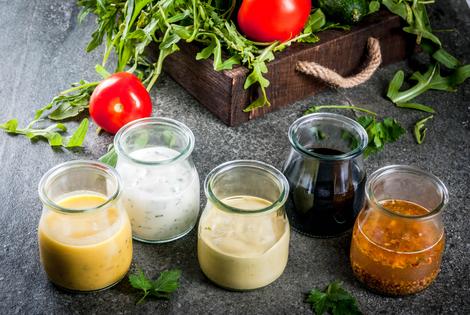How to choose the healthiest salad dressing
Published in Health & Fitness
Salad dressings are an important part of the taste and nutrition of your salad. But with countless varieties of salad dressings on store shelves, picking out a healthy one can feel overwhelming. Here’s how to choose a healthy salad dressing, including what ingredients to look for and avoid, and nutrition stats to be aware of.
What makes salad dressing healthy?
A healthy salad dressing should ideally align with something you would make at home, with just a few simple ingredients and not too much added saturated fat, sugar or sodium. Some store-bought salad dressings include additional ingredients for texture, flavor or coloring, like emulsifiers, dyes and syrups.
What to consider when choosing salad dressing
Almost all salad dressings have some sort of fat as the base, which helps balance the acid in the dressing. The healthiest salad dressings contain unsaturated fat from foods like olive oil, canola oil, and avocado oil, rather than saturated fat from foods like sour cream or mayonnaise.
In addition, the 2020-2025 Dietary Guidelines for Americans recommends limiting saturated fat intake to 10% of daily calories. Dressings that are rich in saturated fat may fill your daily allotment, especially since many people eat more than the recommended serving size (usually about 2 tablespoons) of salad dressing.
The same goes for added sugar, which most Americans overdo it on in their typical patterns. Most dressings have some added sugar to help balance their flavors, but read the Nutrition Facts panel to choose a salad dressing with the lowest amount.
Healthiest salad dressing options
Look for a dressing with a base of unsaturated fat like olive oil, avocado oil, canola oil, vegetable oil, or sesame oil. Try to find creamy dressings that also contain a base with unsaturated fat or protein, such as avocado, nut butter or yogurt. Usually, these are the first ingredients on the label, followed by some sort of acid, like vinegar or lemon juice.
A healthy dressing is also lower in added sugar and sodium. Although there are no set guidelines for the amount of sugar and sodium in a dressing, try to find one with the lowest percent of the Daily Value of each. For example, a dressing with less than 5 grams of added sugar and less than 200 milligrams of sodium would only contribute about 10% of your daily intake for both nutrients.
Salad dressings to limit
Try to limit your intake of salad dressings that are high in saturated fat, added sugar, and sodium. This typically includes dressings with sugar, sour cream, heavy cream or mayonnaise as the first ingredient. In addition, low-fat dressings usually contain more added sugar to enhance their taste.
If you enjoy these types of salad dressings, this does not mean you need to cut them out entirely. Instead, be mindful of how much of them you consume, and how frequently, and how they fit into the rest of your day and eating pattern.
Make a dressing at home
Making a salad dressing at home allows you to customize the flavors and nutrition to your liking. Plus, homemade dressings are usually healthier and tastier than the store-bought varieties, and they can be completely customized to your flavor and nutrition preferences. Not to mention, it’s much easier to control the amount of added sugar and salt.
(EatingWell is a magazine and website devoted to healthy eating as a way of life. Online at www.eatingwell.com.)
©2024 Dotdash Meredith. All rights reserved. Used with permission. Distributed by Tribune Content Agency, LLC.










Comments